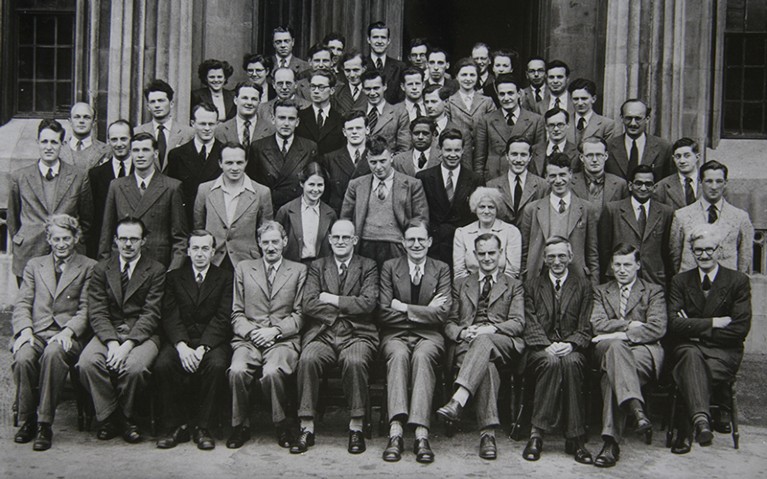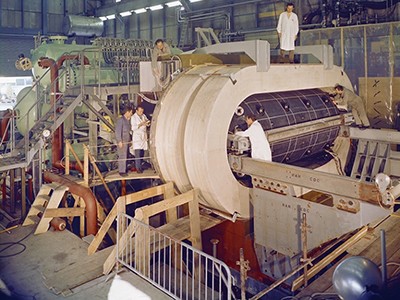
Parity symmetry says that something viewed in a mirror should look the same.Credit: Getty
When a ‘scanner’ called Minnie van der Merwe handed Rosemary Brown a photographic slide with an unusual configuration of particle tracks, the physicist knew that she was on to something. “I looked very carefully and thought: this is it,” she says.
That was in 1948, when Brown — now 97 and known by her married name of Fowler — was a 22-year-old PhD student in Cecil Powell’s group at the University of Bristol, UK. She was looking at particle tracks in photographic emulsions that had been exposed to cosmic rays. Before the advent of particle accelerators, such emulsions were the main source of data for exotic high-energy particles. Fowler was in little doubt about what she had found in what became labelled the ‘k-track’ plate — but working out the ‘why’ of her discovery occupied particle physicists for the best part of a decade. When they finally managed it, it blew apart the idea that the laws of nature adhered to certain symmetrical ways of working, with reverberations that continue to this day.
Does quantum theory imply the entire Universe is preordained?
The decades either side of the Second World War were a boom time for particle discovery. The 1930s had seen the list of subatomic particles grow beyond the duo of the electron and proton, with the discovery of the neutron, the muon (a heavier version of the electron) and the first antimatter particle, the positron. In 1947, Powell confirmed the existence of the pion1, the first of a new class of particles known as mesons. These were predicted in 1934 by Japanese physicist Hideki Yukawa to be carriers of the strong nuclear force — one of the four fundamental forces of nature. (Mesons are now known to be made up of quarks, the interactions of which, through the exchange of gluons, are the basis of this force.)
In December 1947, George Rochester and Clifford Butler at the University of Manchester, UK, took the meson discovery a stage further. They detailed how, in 5,000 cloud-chamber photographs, they had found evidence2 of what they called the theta zero (ϴ0), a neutrally charged meson that decayed into pions. Fowler’s discovery just a few months later was both similar and strikingly different. Powell’s laboratory had perfected the technique of using emulsion plates to investigate the contents of cosmic rays entering Earth’s atmosphere. The k-track plate came from a set exposed at the high-altitude lab, at Jungfraujoch, Switzerland, located 3,571 metres above sea level. It revealed a particle, identified as ‘tau’, with the same mass as a ϴ0, but that decayed differently: to three pions, rather than two.
A mirror crack’d
An intense period of work followed the discovery. “A lot of measurement and calculation had to be done before the finding could be published. We knew it was an important discovery so worked very hard to get everything done quickly,” says Fowler. The team wrote three papers in quick succession, including two that were published in Nature in January 1949. All three listed Fowler (then Brown) as the first author3–5. This followed the convention that authors be listed in alphabetical order, but also recognized that she had been the one to make the discovery.
Grasping the implications of Fowler’s discovery means delving into what was thought to be a fundamental symmetry of nature, known as parity. The statement ‘parity symmetry is conserved’ amounts to saying that a mirror-reflected version of a physical process should occur just as readily in nature as the original process does. In particle physics, parity symmetry is expressed by a quantum number describing how a particle acts if you flip it in one spatial coordinate. Total parity is calculated by multiplying the parity numbers of all the particles involved at the different stages of a particle process. If parity symmetry is conserved, the total parity cannot change.
The particle-physics breakthrough that paved the way for the Higgs boson
A pion has a parity of −1, so the three-pion end state of Fowler’s tau-meson decay also has an overall parity of −1. But the two-pion end state of the ϴ0 decay has parity +1. If parity is conserved, the two initial particles must have distinct parities, too — and should therefore be different types of particle. But no theoretical concept could explain why two particles of different types could have exactly the same mass. This became known as the tau–theta puzzle.
After Fowler’s first observation, many groups followed in her tracks. They scoured cloud-chamber photographs and flew stacks of emulsions high into the atmosphere in weather balloons to look for signs of the tau-meson decay. By 1953, this activity had led to a total of 11 events. By 1955, 35 more events had been produced using the Bevatron, an enormous particle accelerator at Lawrence Berkeley National Laboratory in Berkeley, California, that provided an alternative source, beyond cosmic rays, of high-energy particles. Along the way, a new naming convention was introduced: the initial particles became known as K mesons or kaons, and theta and tau referred instead to the decay modes that resulted in two and three pions, respectively. Given that all the researchers involved would have been familiar with Fowler’s k-track, it seems a highly likely source for this convention.
With more-precise measurements, the masses of the two types of kaon remained identical and the tau–theta puzzle only became more perplexing. Finally, in April 1956, particle physicists gathered at a conference in Rochester, New York, to thrash out exactly what was going on with kaons, and several other confusing ‘strange’ particles that had been discovered in the meantime. Neither Fowler nor Powell was there, but luminaries such as Murray Gell-Mann and Richard Feynman were. In Gell-Mann’s recollection, Feynman was sharing a room with experimentalist Martin Block, who asked him: “What if parity isn’t conserved? Then couldn’t the tau and theta be the same thing?” Feynman proposed this at the meeting. It turned out that no one had ever actually proved that parity was conserved, especially in the weak-nuclear interaction, which governs kaon decays.

In 1948, Rosemary Brown (back left, next to pillar) was one of few female physicists at Bristol.Credit: Archives of the School of Physics/University of Bristol
Theorists Tsung-Dao Lee and Chen-Ning Yang were also at that meeting, and that October proposed that parity might be violated6. At first their paper was viewed with scepticism, with Feynman even placing a personal bet with odds of 50:1 against parity violation. An experiment was needed to confirm or refute the idea. That experiment was conducted, also in 1956, by Chien-Shiung Wu at the National Bureau of Standards in Washington DC. She showed conclusively that parity was not conserved in the β decay of cobalt-60, which also occurs through the weak nuclear force7. Other experimental results soon added to the pile, until it was undeniable. The solution to the tau–theta puzzle was that the two types of kaon were one and the same, but parity was not a fundamental symmetry of nature.
So neat was Wu’s experiment that she also managed to prove that nature broke a second symmetry, called C for charge conjugation. This expresses the idea that if you swap all the particles in an interaction with their antiparticles, the interaction should still happen in the same way. This finding set the stage for physicists to revise their views on other assumed symmetries of nature. ‘CP’, the combination of charge and parity conservation, was proposed to hold, but was then shown to be violated in 1964 — also in decays of kaons.
Also in 1964 came the idea of ‘spontaneous’ symmetry breaking in particle physics, followed in 1967 by the application of this idea to ‘electroweak’ symmetry breaking. Electroweak theory explains how the weak nuclear and electromagnetic forces are unified at high energies, such as those prevalent in the early Universe, but seem to us to be distinct forces mediated by particles of very different masses. Spontaneous symmetry breaking suggested the existence of the Higgs boson — a particle eventually discovered in 2012 at the Large Hadron Collider at CERN, Europe’s particle-physics laboratory near Geneva, Switzerland. Today, asymmetries in decays of kaons and other particles being investigated at CERN and elsewhere might point the way towards new effects beyond the standard model of particle physics.
The ‘Matilda’ effect
The seminal nature of her discovery raises the question of why so few people have heard of Fowler. In most physics departments of her time, gender parity was maximally violated. Powell’s lab was something of an exception. The confluence of war time and a new approach to science had shifted its gender balance. The large amounts of photographic data being gathered meant that Powell had employed teams of scanners, including van der Merwe. These scanners, most of whom were women, painstakingly trawled through the photographs, handing over anything unusual or interesting to one of the physicists for further analysis.
Centenary of particle pioneer
Fowler was not a scanner. She was one of the few women invited to do a physics PhD, after achieving a first-class degree — an exceptional result for anyone especially in those days. Smart and decisive, she took just two days’ holiday, and started work in June 1947. After making her discovery, the first person she told was fellow PhD student Peter Fowler. “We spent a little while looking and thinking and enjoying the moment of discovery. Then I told the others,” she says. The grandson of nuclear pioneer Ernest Rutherford, Peter Fowler was widely regarded as a brilliant young physicist. Three years older than Rosemary, he was a year below her, because his studies had been interrupted by war service. The two married in July 1949.
When I asked Rosemary why she left physics after that, without completing her PhD, I expected a difficult conversation, but her response was pragmatic. Living in a time of food rations, housing shortages and great sacrifice, and with no time-saving appliances or childcare for their three girls, she decided that it would be best for physics if Peter kept working. She would assist him with his work from home, keep the house and raise their children — and having made that decision, that is what she did.
Rosemary’s contribution has, over time and in various publications, often been attributed to her husband or to Powell. There seems to be no maliciousness about this — Powell was meticulous in acknowledging contributions. But it does seem to be a prime example of the ‘Matilda’ effect, the phenomenon that female scientists’ contributions are often overlooked or attributed to their male counterparts.
Rosemary is by no means the only one, even in this story. Powell won the Nobel Prize in Physics in 1950 for the discovery of the pion using the emulsion technique, while the contributions of the technique’s inventor, Austrian physicist Marietta Blau, were overlooked. Evidence for the pion also appeared in Nature papers by Indian physicist Bibha Choudhuri, published during the Second World War8; her work is even less well known than Blau’s. Lee and Yang were awarded the Nobel Prize in Physics in 1957 for their work on parity violation; Wu received no such recognition. Now, 75 years after Rosemary’s discovery and with the long view of its importance in physics, it seems fitting to set her part of the record straight.






